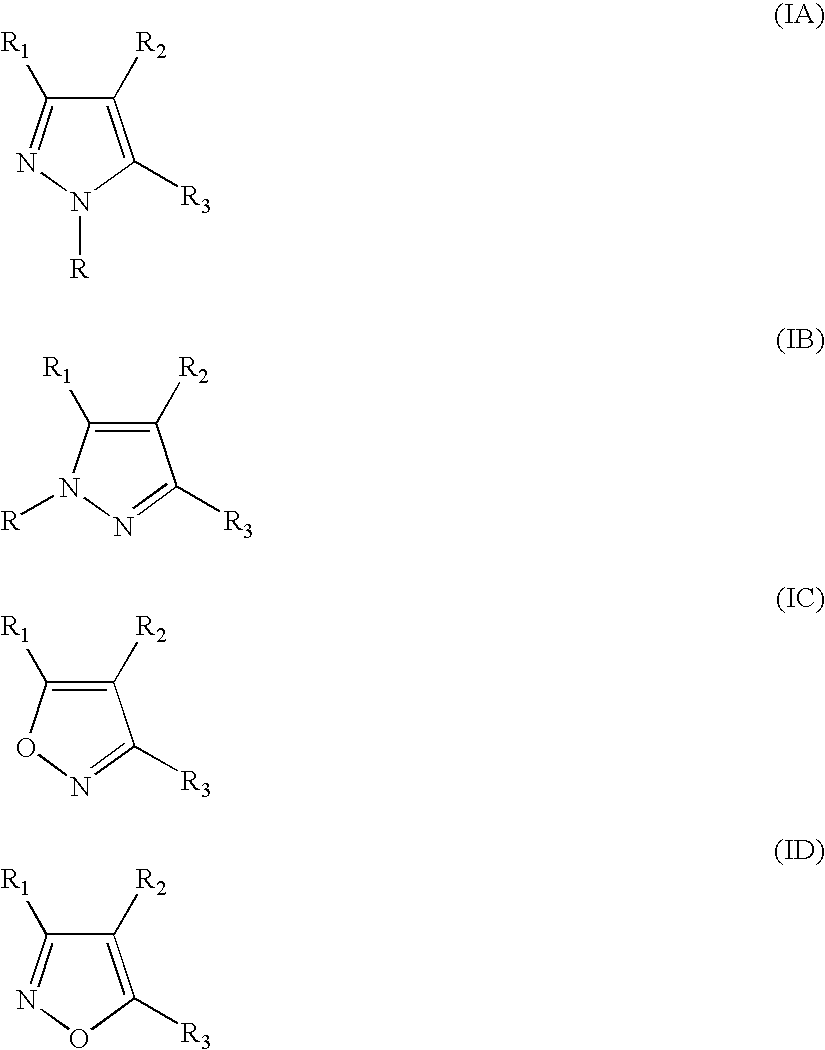Substituted 5-membered ring compounds and their use
a technology ring compounds, which is applied in the field of substituting ring compounds, can solve the problems of radicicol lacking antitumour activity in vivo, deregulation of molecular and physiological functions in the cell, and inhibition of hsp90 function and degradation of a number of hsp90-chaperoned signalling proteins
- Summary
- Abstract
- Description
- Claims
- Application Information
AI Technical Summary
Problems solved by technology
Method used
Image
Examples
example 1
1-(2,4-Dihydroxy-phenyl)-5-(4-fluoro-phenyl)-1H-[1,2,3]triazole-4-carboxylic acid
[0083]
Step 1
1-Azido-5-chloro-2,4-dimethoxy-benzene
[0084] To a solution of concentrated H2SO4 (5 mL) in water (15 mL), 5-chloro-2,4-dimethoxy-phenylamine (3 g, 16 mmol) was added, resulting a deep purple suspension. More water (15 mL) was then added and the mixture was cooled and stirred vigorously at 0° C. in an ice-salt bath. A solution of sodium nitrite (1.2 g, 17.4 mmol) in water (5 mL) was added slowly and a brown solution was obtained. This solution was stirred at this temperature for an hour. After that, a solution of sodium azide (1.2 g, 18.5 mmol) in water (10 mL) was followed and the solution turned grey. This solution was then stirred for an hour. The grey precipitations (1.0 g, 30%) formed were collected, washed with water and dried. Yellow solids formed in the filtrate were also collected, washed and dried. The second crop (1.47 g, 43%) turned to light grey quickly.
[0085]1H NMR (d6-ac...
example 2
[0094] 1-(2,4-Dihydroxy-phenyl)-5-(4-fluoro-phenyl)-1H-[1,2,3]triazole-4-carboxylic acid ethyl ester
[0095] 1-(2,4-Dihydroxy-phenyl)-5-(4-fluoro-phenyl)-1H-[1,2,3]triazole-4-carboxylic acid (0.15 g, 0.48 mmol) was refluxed in EtOH (20 mL) in the presence of 5 drops of concentrated H2SO4 for 3 hours. After evaporation of the solvent, EtOAc (20 mL) was added. The organic layer was then washed with sat. NaHCO3 (2×10 mL) and brine (20 mL), dried with NaSO4 and filtered. After evaporation of the solvent, light brown semi-solids (93 mg, 57%) were obtained and purified by prep. TLC (Rf=0.73, EtOAc).
[0096]1H NMR (d6-acetone): 8.90 (1H, s, broad); 7.46 (2H, dd, J=9.0 and 5.4 Hz); 7.20 (1H, dd, J=8.6 and 0.8 Hz); 7.12 (2H, dd, J=9.0 and 8.9 Hz); 6.46 (1H, d, J=0.8 Hz); 6.44 (1H, dd, 8.6 and 2.5 Hz); 4.25 (2H, q, J=7.0 Hz) and 1.20 (3H, t, J=7.0 Hz)
[0097] LC retention time 6.58 minutes [M+H]+ 344.1
example 3
1-(5-Chloro-2,4-dihydroxy-phenyl)-5-(4-fluoro-phenyl)-1H-[1,2,3]triazole-4-carboxylic acid ethyl ester
[0098]
Method:
1-(5-Chloro-2-hydroxy-4-methoxy-phenyl)-5-(4-fluoro-phenyl)-1H-[1,2,3]triazole-4-carboxylic acid ethyl ester and 1-(5-Chloro-2,4-dihydroxy-phenyl)-5-(4-fluoro-phenyl)-1H-[1,2,3]triazole-4-carboxylic acid ethyl ester
[0099] 1-(5-Chloro-2,4-dimethoxy-phenyl)-5-(4-fluoro-phenyl)-1H-[1,2,3]triazole-4-carboxylic acid (38 mg) was refluxed in HBr (48%, 1 mL) and acetic acid (1 mL) for 16 hours. When cooled, water (10 mL) was added and the aqueous layer was extracted with EtOAc (2×10 mL). The combined organic layers were then washed with brine (2×10 mL), dried with NaSO4 and filtered. After evaporation of the solvent, the crude acid mixture was dried in vacuum and used in the next step. 1Hnmr and LCMS of the crude mixture were analysed. EtOH (6 mL) and 3 drops of concentrated H2SO4 were added to the above acid mixture and refluxed for 2 hours. After evaporation of the solv...
PUM
| Property | Measurement | Unit |
|---|---|---|
| molecular weight | aaaaa | aaaaa |
| disorders | aaaaa | aaaaa |
| cellular stress | aaaaa | aaaaa |
Abstract
Description
Claims
Application Information
 Login to View More
Login to View More - R&D
- Intellectual Property
- Life Sciences
- Materials
- Tech Scout
- Unparalleled Data Quality
- Higher Quality Content
- 60% Fewer Hallucinations
Browse by: Latest US Patents, China's latest patents, Technical Efficacy Thesaurus, Application Domain, Technology Topic, Popular Technical Reports.
© 2025 PatSnap. All rights reserved.Legal|Privacy policy|Modern Slavery Act Transparency Statement|Sitemap|About US| Contact US: help@patsnap.com



